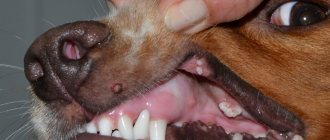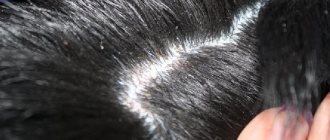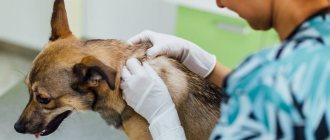Abscess concept
An abscess in dogs is an inflammatory process that occurs in the skin, which is accompanied by the formation and accumulation of purulent formations due to necrosis (rotting) of tissue. A bag of pus, pieces of necrotic tissue and pathogenic microflora forms under the skin. Around the sac, the tissue becomes inflamed and the walls of an abscess begin to form, which consists of a surface layer formed by fibrous connective tissue and an internal, pyogenic layer of granulation tissue. If no measures are taken, the bag will grow and bother the animal. In addition to being painful, abscesses negatively affect the overall health of your pet.
The disease can be localized in any part of the body due to mechanical damage: bruises, injuries and injections. And if there are malfunctions in the functioning of the secretory organs, then an abscess of the gland may develop in the dog.
When the paraanal gland becomes inflamed, the excretory canal is blocked and the secretion accumulates inside. Finding no way out, the fluid overflows the gland, and the wall and skin rupture. This is an abscess of the paraanal gland in a dog, which resembles an ulcer.
Why do boils appear?
The immediate cause of the development of an abscess in a dog is the entry into the body of pathogenic microflora that can cause suppuration - a purulent or serous-purulent infection. The second possible reason is the creation of favorable conditions for the active reproduction of “own” pyogenic bacteria, for example, against the background of a general weakening of the immune system. From this point of view, an abscess can occur as an independent problem or represent a complication of another, more serious disease. In the first case, the infection enters the body directly from the external environment through skin lesions, in the second, it spreads throughout the body from the focus of purulent inflammation along with blood or lymph.
Important! Most often, a purulent inflammatory process in the subcutaneous tissues is caused by Staphylococcus aureus and white, as well as streptococci and E. coli.
The most common events that precede the appearance of superficial ulcers are wounds, scratches and other damage to the skin, especially if the violation of the integrity of the skin is associated with poor hygiene or did not receive immediate antiseptic treatment. For example, an abscess on a dog’s body very often occurs after a fight with another animal or an insect bite. Factors that increase the risk of infection include the general health of the pet, the individual characteristics of the body, as well as some errors in care. In particular, the situation can be aggravated by:
- poor nutrition;
- keeping the animal in unsanitary conditions or in a room with high humidity;
- skin problems - dermatitis, eczema, ectoparasites, fungal infections, increased work of the sebaceous glands, etc.;
- tendency to allergic reactions;
- poor immunity;
- helminth infection.
The infectious agent, once in the body, begins to actively multiply, causing extensive tissue swelling. A protective reaction to this process is the active production of lymphocytes - white blood cells, the main “weapon” of the immune system. It is they who quickly “surround” and block inflammation, preventing it from spreading further, resulting in the formation of a dense capsule filled with pus - a mixture of dead blood cells, dead and living bacteria.
Important! A furuncle is one of the most common types of superficial abscess, occurring as a direct consequence of infection in a lesion on the skin.
Examples of non-infectious internal diseases, the complication of which are sometimes abscesses, in addition to the already mentioned pulpitis and paraanal sinusitis, include:
- sore throat;
- paratonsillitis;
- pneumonia;
- pancreatitis;
- cholecystitis;
- stomach or duodenal ulcer;
- osteoarticular tuberculosis, etc.
There are cases when an abscess on a dog’s body occurs for reasons not related to pathogenic microflora. For example, there is a special type of so-called chemical abscesses, in which inflammation in the soft tissues is a reaction to the penetration of a drug into them.
Just such an example is a lump under the skin that occurs after an unsuccessful injection due to:
- injury to a blood vessel;
- damage to the nerve ending;
- using a blunt needle or an instrument that is not suitable in size (length, diameter, etc.);
- administering the drug too quickly;
- poor disinfection;
- other violations of injection technique;
- allergic reaction to medication;
- characteristics of the administered drug (for example, the ability to cause spasms of muscles or blood vessels).
Did you know? Doctors learned to administer medications into a vein in the middle of the 17th century, but the syringe in its modern form (a container with medicine inside which a piston moves, connected to a needle to pierce the skin) was invented only a century later. It is interesting that the idea of the device came to the minds of two scientists at once - Charles Gabriel Pravaz (France) and Alexander Wood (Scotland).
Causes of abscess
The occurrence of an abscess is associated with the penetration of pathogenic microorganisms into tissues through wounds and abrasions. Also, such a reaction can be provoked by toxic substances that get under the skin. Often, an abscess in dogs forms when a purulent process begins in hematomas and lymphatic drainages, as well as when microorganisms are transferred by the bloodstream from the source of suppuration.
This disease is quite common among four-legged pets. According to statistics, every second dog suffers from an abscess, but the reasons for its occurrence vary:
- injections;
- abrasions, scratches, injuries, bruises;
- wound contamination;
- lack of hygiene procedures or lack thereof;
- microbes and bacteria;
- improper care.
Before starting treatment, it is necessary to determine the nature of the abscess and establish the degree and form of the disease.
Types and forms of abscesses
In veterinary medicine, there are several criteria by which abscesses are classified.
Morphological composition of purulent formations and bacteria provoking the process:
- hot or spicy;
- cold, or chronic.
- superficial, which develops in the skin and subcutaneous tissues;
- deep, which can be subfascial, intermuscular, intramuscular, subperiosteal, bone, subperitoneal, abscess of organs and glands, depending on the location.
With a benign abscess, thick, creamy, purulent accumulations are formed, with an increased content of leukocytes, without microbes or with little presence of them. A benign abscess can form if low-virulent staphylococci penetrate the tissue or when irritating substances are introduced under the skin. Such an abscess often forms after an injection in a dog.
In a malignant abscess, the purulent formations are watery and thin, with a high concentration of pathogens and low production of white blood cells. The causative agents of the malignant process are purulent-putrefactive and anaerobic microbes. This type of abscess in dogs is more painful and will not go away on its own. It can develop into a more complex form and affect adjacent tissues. Such formations require surgical intervention; in other words, they are removed through surgery.
With a hot abscess, a pronounced inflammatory process is observed, which is characterized by an acute course and the rapid formation of an abscess, which often opens spontaneously, that is, it breaks through and the pus flows out.
With a cold abscess, the main signs of inflammation are weak, and pus accumulates slowly, which makes timely diagnosis difficult. Such abscesses are typical of old and emaciated dogs that move little. An abscess is formed in the presence of low-virulent microorganisms.
Varieties
The following types of abscesses are distinguished:
- Benign. As a rule, the result of unsuccessful vaccinations, injections, blows and injuries. It looks like a reddish swelling, the cavity of which is filled with thick purulent liquid.
- Malignant. It looks like watery red bumps that are not elastic to the touch, inside of which there is liquid pus.
- Cold. The cone ripens slowly and almost never opens spontaneously. As a rule, this is a “diagnosis” of old dogs with weak immunity.
- Hot. It forms quickly and is accompanied by an increase in body temperature. The swelling is painful and often opens on its own.
How to recognize the disease
An abscess in a dog, the photo of which is presented in this article, can be determined visually if the symptoms are severe, but in some cases it cannot be done without special examinations. Symptoms differ for different inflammatory processes.
Symptoms of a benign abscess:
- swelling with clear edges;
- redness;
- pain when touched.
Symptoms of malignancy:
- formation of a soft tubercle;
- increased body temperature of the animal;
- severe pain when pressed.
An abscess of a dog’s paraanal glands not only gives external symptoms, but also affects the general condition of the pet’s body. Observed:
- lethargy;
- gloominess;
- increased body temperature;
- lack of appetite;
- apathy and indifference to walks;
- the anal area becomes inflamed;
- purulent ulcers form;
- there is pain in the adjacent tissues.
You should not try to clean the wound yourself, so as not to harm the animal. You should immediately contact a specialist.
If the symptoms do not indicate a specific type of abscess, and the pet’s condition worsens, then you should immediately contact the veterinary clinic. Timely diagnosis and proper treatment will help avoid complications.
How is the diagnosis carried out?
Diagnosis of a superficial abscess is carried out by clinical examination and palpation. It is at this stage that the veterinarian differentiates a purulent abscess from a tumor based on the following distinctive features:
| Distinctive feature | Tumor | Abscess |
| Structure | homogeneous | inhomogeneous (presence of fluctuations) |
| Pain on pressure | No | There is |
| Redness | No | There is |
| Skin temperature in the compaction area | regular | increased |
In the above list, the determining criterion is the first point, all others are secondary. For example, the cold form of an abscess is not characterized by the main signs of purulent inflammation, while among tumors there are painful varieties.
Important! Tumors, like abscesses, are different, and the differences between them are not always obvious, so you should not diagnose yourself.
To detect deep abscesses, a veterinarian, based on the general clinical picture (specific signs of illness), may prescribe a number of clarifying tests and studies, including:
- general blood test (allows you to determine the presence of a bacterial infection);
- blood test for parasites;
- radiography (eg, to detect a periapical abscess);
- electroodontometry (a special technique for testing the condition of the pulp);
- ultrasound examination of internal organs;
- computed tomography (if a lung or brain abscess is suspected);
- biopsy followed by cytological and microscopic examination of the contents of the abscess, etc.
Diagnostic methods
Abscesses have much in common with hematomas, hernias and tumors, but the symptoms and contents of the formations are different. Therefore, in order to establish an accurate diagnosis and prescribe the correct treatment, the doctor conducts an examination and prescribes a number of examinations:
- the course of the disease is studied;
- the abscess is examined and palpated;
- a puncture is performed to study the contents;
- compare the temperature of the affected area and healthy tissue.
If necessary, an MRI or ultrasound may be prescribed. This is especially true for internal formations.
Causes
Most abscesses occur in dogs due to a puncture wound (such as a bite from a dog fight or a scratch from a cat's claws). It can be caused by wild plants or twigs that leave a wound on the dog's paw. This usually happens on the pad itself, between the fingers. It is painful for the dog to step on the affected area, and it begins to limp if the interdigital fold becomes inflamed.
An abscess has many potential causes, but usually forms when a dog's wound becomes infected with bacteria. Pasteurella multocida is the bacteria that most commonly causes skin infections in dogs. Staphylococcus intermedius is another bacterium that causes abscesses and can be treated with ointment. An abscess forms when these bacteria are present and wounds are neglected.
Causes that also cause bacterial infection include wounds in the mouth from sharp objects and ingrown hairs. Some breeds are predisposed to developing abscesses. These include the Chinese Shar-Pei, English Bulldog and Labrador, notably, they all have short, coarse hair.
Street dogs are also predisposed to similar pathologies. Damage to the skin, mouth and lungs is more common in these individuals, they have worse living conditions, and are more likely to come into contact with sharp, dirty objects. Swallowing or inhaling herbs with pungent seeds can also cause organ damage.
Dogs that have not been spayed or neutered also tend to develop abscesses as they are more likely to fight other animals and get bitten. Old male dogs who have not been neutered are at higher risk of prostate disease, which may include prostate abscess, and old female dogs are at risk of mammary gland infection.
The disease can also affect a small puppy, who pulls various objects into his mouth when he is teething. In addition, his paws are softer, which indicates a greater likelihood of damage; then, with mechanical damage to the tissue between the toes, the inflammatory process quickly begins.
Other causes of abscesses include affected anal sacs, blood infections that lead to liver abscesses, sinusitis, or oral infections. They can also cause a brain abscess. Almost any wound, even a small one, can become infected, leading to inflammation.
How to treat the disease
Treatment of the disease is carried out using different methods. The veterinarian should prescribe a course of general and local therapy or recommend surgery.
If a benign abscess is diagnosed in a dog, treatment is carried out with medication, which consists of:
- absorbable ointments used to treat unruptured formations;
- antiseptic solutions for treating wounds in case of spontaneous opening of an abscess;
- antiseptic ointments that are applied to the wound channels.
The affected area should be washed with a syringe so as not to cause unnecessary inconvenience to the pet.
When a malignant abscess is diagnosed, surgery is prescribed to remove the purulent sac. Manipulation should be carried out as quickly as possible, before the disease spreads to adjacent tissues. In the postoperative period, general and local therapy and a course of antibiotics are carried out.
If the paraanal glands are affected, treatment should be carried out in a clinical setting. After examination and determination of the extent of the problem, drug treatment in combination with warm compresses will be prescribed. In more serious cases, the veterinarian will open and treat the abscess himself. Often, additional drainage is required to remove pus. Afterwards, treatment with strong antibiotics is prescribed to suppress pathogenic microflora, using rectal suppositories and local treatments.
Prognosis and prevention
When treating acute superficial benign abscesses, the prognosis is favorable. In the case of cold formations, with paraproctitis - cautious, with abscess of internal organs - doubtful.
It is impossible to prevent dogs from getting skin or paw injuries. Everything must be done to ensure that the pet’s immune system is able to cope with adverse factors on its own. Therefore, it is necessary to organize nutrition with ready-made food of at least premium class or natural products of similar quality.
Animals should not be overfed with bones, so as not to cause constipation, or with human delicacies, which cause digestive disorders and negatively affect the immune system. It is necessary to regularly carry out immunization in accordance with the vaccination plan, and expel worms quarterly.
Preventive actions
By following a number of simple rules, you can protect your pet from the disease and prevent the formation of purulent lumps. These include:
- maintaining careful hygiene;
- regular inspections of the animal for damage;
- treatment of even minor wounds;
- ensuring proper care of the animal;
- regular veterinary examinations.
Abscesses cannot be ignored to prevent complications. An abscess can form in a short time and grows rapidly, affecting and destroying healthy tissue, and there is also an intensive proliferation of microbes that can infect the entire body of the animal.
What is an abscess in a dog?
This is what they call a large abscess. It can be closed or open. The first is visible under the skin; there may be a through passage. The open one releases liquid regularly and does not tighten. Abscesses are dangerous because they open the way to all kinds of infections.
The cause is bacteria, a foreign body, tissue unknown to the body. A purulent abscess in a dog appears like this:
- The body detects the bacteria and tries to isolate it.
- Blood flow to the area increases, and leukocytes try to destroy the pathogen.
- An insulating capsule is formed at the site of localization under the skin.
- Pus is dead blood cells.
- If the immune system fails to cope with the problem, the abscess continues to grow.
A capsule rupture leads to the spread of pathogenic microorganisms through the bloodstream throughout the body. This is fraught with serious intoxication and illness. Therefore, abscesses should be taken seriously.
Symptoms: swelling, increased local temperature, pain. Dogs often encounter ulcers, some go away on their own, while others cause discomfort and pain.
Abscesses on a dog’s body: causes, localization
Doctors call bite wounds another common cause of abscesses. If your pet is bitten while playing with another dog, and you do not treat the area, an abscess may appear. With serious open wounds, the risk of infection is much higher: the area is treated several times a day, a bandage is applied, and internal therapy (antibiotics) is used.
An abscess on a dog's neck appears due to a tight or hard collar. If heavy leather products, weighted with spikes or chains, are suitable for large dogs, then narrow soft models are selected for Yorkies. Also, miniature breeds should not have a harness attached to a neck leash: they have a fragile neck. It is better to use a leash that fits around the body (like a cat's leash).
If your dog has an abscess on his face, you should be wary. It is located in close proximity to the brain, jaw, and large vessels. It happens that a pet scratches a lip or cheek, and by licking the wound, it causes an infection.
Such ulcers interfere with eating; pus gets on the mucous membranes, which can spread. Therefore, an abscess on the face requires close attention and treatment.
A common place for boils. Firstly, some breeds have it docked. If the procedure is performed under unsterile conditions, there is a possibility of an abscess. Secondly, a dog develops an abscess on its tail due to active play or accidental injury. In any case, it needs to be examined and removed by yourself or by a veterinarian.
How to provide first aid to a pet with pus discharge from the eyes
When the first purulent discharge is detected, it is recommended to make an appointment with a veterinarian to identify the cause and protect the dog from the development of inflammatory processes in the body. Before visiting a veterinarian, you can help your pet yourself.
If a dog's eyes are purulent, how to properly treat it at home or what measures should be taken to prevent excessive purulent discharge?
- Rinsing the sore eye with furatsilin (1 glass of warm water = 1 tablet) or herbs. You can wash your eyes with chamomile or calendula. Take a cotton swab and soak it in the prepared solution. Wash your eyes with a moistened cotton swab 3 times a day. A separate swab is taken for each eye to avoid infection of the healthy eye. It is permissible to administer a few antibacterial eye drops (for example, chloramphenicol).
- Applying tetracycline ointment under the dog's lower eyelid. Take a small amount of ointment and apply it with gentle point movements under the animal’s slightly drawn-out lower eyelid. The main rule: tetracycline ointment should be 1%, no more. Otherwise, a burn is inevitable. After applying the ointment, the closed eyes are massaged with smooth movements. It is important to prevent the animal’s paws from rubbing the eyes.
- Providing a healthy home regime for dogs - it is recommended to provide the dog with a proper diet and plenty of fluids. It is important to protect your four-legged friend from possible allergens (new food, pollen, dust, household chemicals). In addition, it is necessary to carefully observe the behavior of the animal and record all external and internal changes in the pet to determine the exact picture of the disease.
After providing first aid to the animal, it must be taken to a veterinary clinic, where a professional veterinarian will tell you what to do and how to treat it.
How to treat a dog's abscess yourself
Treatment of an abscess at home is carried out if you are sure that it is a small abscess. Do not touch closed abscesses, puncture them, or make incisions. All instruments and dressings must be sterile. The animal feels pain, so restraint will be required. It is better to treat ulcers that have already opened at home.
Open abscess
A discharge appears from it - pus. As it is released, wipe it with a clean bandage and treat the area with a disinfectant. There is no need to squeeze out the contents, it comes out on its own.
When clear liquid or ichor appears from the wound, it can heal. They also disinfect the area and apply bandages with healing ointments: Levomekol; Stellanin.
If pus still comes out for several days, the abscess becomes larger, or there is an unpleasant odor, consult a doctor.
Veterinarian help
Treatment of abscesses in dogs in a clinical setting is as follows: Small incisions are made in the cavity of the abscess. Drainage tubes are installed. Pus comes out through them. When the capsule shrinks and tightens, it is treated with disinfectants and the incisions are sutured.
Antibacterial therapy is always prescribed to prevent sepsis. The procedure takes from 3 to 10 days depending on the size of the abscess.
Closed abscess
Despite the fact that there are many instructions on how to treat an abscess at home, doctors do not recommend getting rid of deep, closed abscesses on your own. Any autopsy is equivalent to an operation. The house is not sterile, there are no necessary tools, so this can only harm the pet.
It is permissible to monitor the growth of the abscess in order to understand when it will open. Sometimes you can warm it up with ointments like Vishnevsky and Liniment.
Treatment of the disease
Therapy at home is possible with the help of medications or folk remedies. Self-treatment at home lasts no more than 10 days; if the disease progresses during this period, you should urgently contact a veterinarian. But in 90% of cases everything is treated without complications.
Read Signs of distemper in dogs: how to treat at home, types and consequences
Therapy with pharmaceutical drugs
First you need to disinfect the skin; for this, antiseptics are used to treat wounds (hydrogen peroxide, furatsilin, potassium permanganate, iodine or brilliant green). Among them, peroxide is considered the most painless for dogs. The procedure should be carried out 3-4 times a day.
Secondly, if there are ulcers, you need to apply bandages using traction agents. The faster the drug eliminates pus from the wounds, the faster the dog will recover. The most popular pulling agents:
- Vishnevsky ointment;
- Levomekol;
- Ichthyol ointment;
- Tetracycline ointment;
- Syntomycin liniment.
Taking antibiotics requires consultation with a veterinarian, but their use is highly recommended. It is not necessary to take your dog to the clinic; you can consult about medication over the phone. If there is severe pain, painkillers are also prescribed (Analgin can be given).
To strengthen the dog's immune system and overall well-being during treatment of an abscess, vitamin complexes such as Hokamix30, AniVital CaniAge or Excel 8 in 1 can be used.
Herbal treatment
The use of folk remedies pursues the same goals as drug treatment: disinfection, drawing pus from wounds, pain relief and general strengthening of the body. First of all, it is recommended to apply compresses to wounds using celandine:
Dilute canned and freshly squeezed celandine juice with vodka 1 to 4. Soak gauze in the solution and apply to the site of the abscess. The dog should wear the compress 2-3 times a day for 10 minutes.
The recipe for St. John's wort and calendula heals wounds well. To prepare, you need to boil a glass of water, add 20 drops of a mixture of juice of two herbs to the cooled water. Add a pinch of salt. Soak gauze in the solution and apply to the wound 2-3 times a day. The effect of use should be noticeable before the end of the first day of such treatment.
Echinacea or ginseng root are used to strengthen the immune system. Decoctions of nettle, chamomile, plantain and millennial also have antiseptic properties.
Opening an abscess in a dog
Opening an abscess should be performed by a specially trained veterinarian. We do not recommend trying to perform essentially a surgical operation on an animal yourself. With severe progression of the disease, neglect or accumulation of a large amount of pus, veterinarians resort to deliberate opening of the abscess. The sequence of performing the operation in the clinic:
- Antiseptic treatment and pain relief with lidocaine or another drug;
- An incision with a scalpel in the area of the purulent head;
- Expansion of the incision using a Hartmann syringe;
- Suction of pus and cleansing of the resulting cavity;
- Washing with antiseptic agents.
Read Review of antibiotics for dogs: where and how to give injections
Removing abscesses in dogs lasts from 5 to 30 minutes and is practically painless for the pet. In some cases, drainage and a special tube are installed to drain pus in the future if the doctor believes that treatment may be delayed.
There are cases when a dog's abscess opens on its own. The owner must treat the wound, bandage the area and take the sick dog to the doctor.
Diagnosis and treatment
The diagnosis is made by a veterinarian in a veterinary clinic after examining the animal and laboratory testing of urine and blood tests. To determine the nature of the swelling, a diagnostic puncture is used. The presence of internal abscesses in dogs is confirmed by radiographic examination and ultrasound of internal organs.
Treatment of the pathology is recommended to be carried out in a veterinary clinic to avoid the spread of infection in the dog’s body and the death of the animal.
Therapeutic measures consist of promptly opening the abscess with the use of painkillers, removing pus from the abscess capsule, followed by washing the wound with antiseptic solutions and applying anti-inflammatory ointments. Treatment of large abscesses involves excision of healthy tissue, suturing and drainage dressing. For internal cases, abdominal surgery with further postoperative treatment of the wound is indicated.
For any type of abscess, the sick dog is prescribed a course of antibiotics. Vitamins and immunostimulating drugs.











